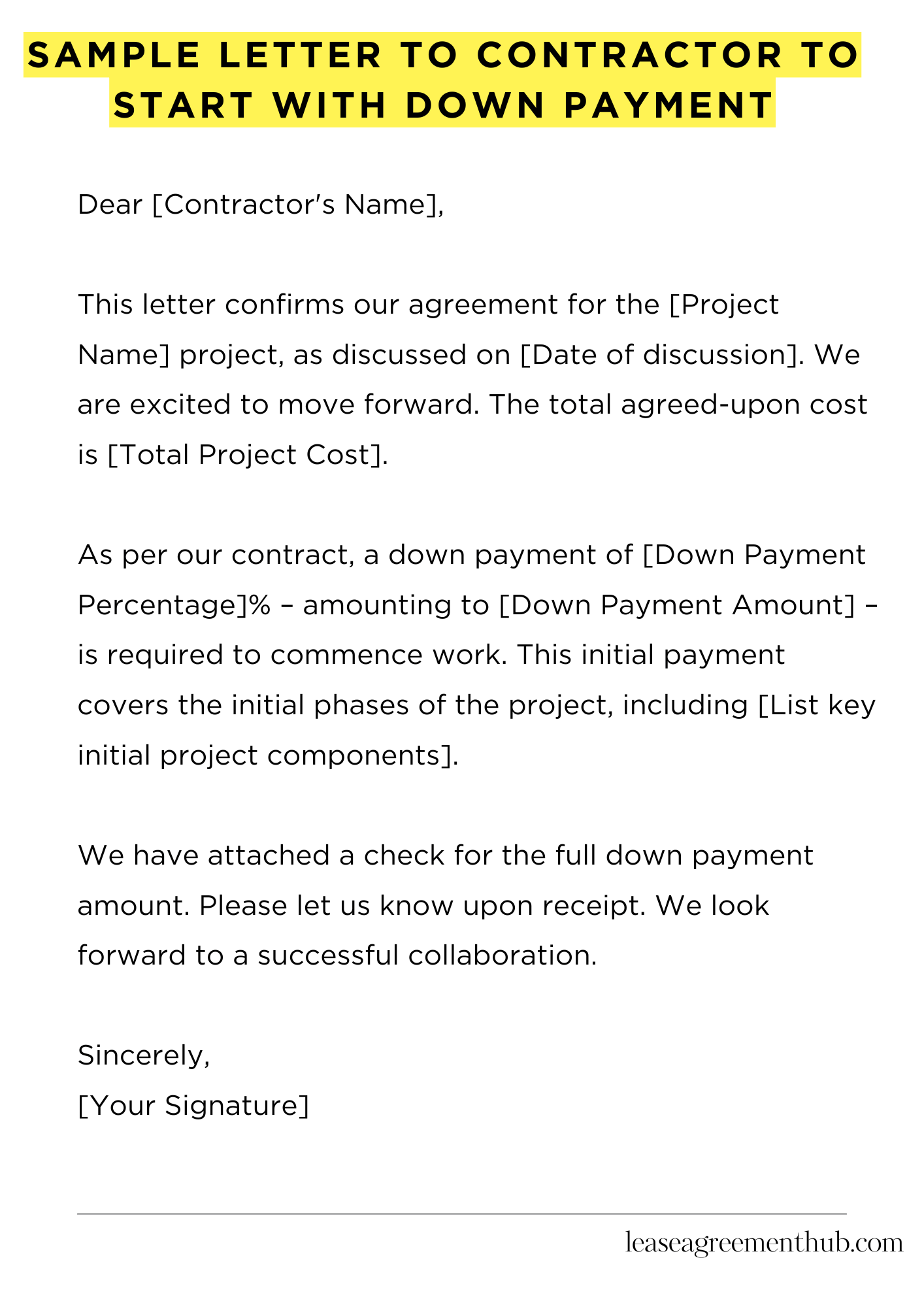A sample letter to a contractor initiates a project with a down payment. It’s a formal request. It protects both parties.
This article gives you letter examples. We offer various templates. Use them to create your own letter.
These samples make writing easy. They’re ready to use. Save time and effort.
Sample Letter to Contractor to Start with Down Payment
[Your Name]
[Your Address]
[Your Phone Number]
[Your Email Address]
[Date]
[Contractor’s Name]
[Contractor’s Company Name]
[Contractor’s Address]
Dear [Contractor’s Name],
This letter confirms our agreement for the [Project Name] project, as discussed on [Date of discussion]. We are excited to move forward. The total agreed-upon cost is [Total Project Cost].
As per our contract, a down payment of [Down Payment Percentage]% – amounting to [Down Payment Amount] – is required to commence work. This initial payment covers the initial phases of the project, including [List key initial project components]. We believe this is a standard practice within the industry and ensures a smooth and timely start.
We have attached a check for the full down payment amount. Please let us know upon receipt. We look forward to a successful collaboration. The remaining balance, [Remaining Balance Amount], will be payable according to the payment schedule outlined in our contract.
Prompt commencement of the project is important to us. Please confirm your earliest availability to begin work. We anticipate the project will be completed by [Project Completion Date], as discussed. We understand unforeseen circumstances can arise; however, timely communication is paramount.
Thank you for your time and attention to this matter. We eagerly anticipate beginning the project.
Sincerely,
[Your Signature]
How to Write a Sample Letter to Contractor to Start with Down Payment
The Importance of a Well-Crafted Letter
A meticulously composed letter serves as a crucial linchpin in initiating a professional working relationship. Ambiguity is the enemy of efficient project commencement. A clear, concise letter minimizes misunderstandings and sets the stage for a successful collaboration.
Understanding the Nuances of Down Payment Agreements
Before drafting your letter, thoroughly comprehend the stipulations of your contract. Clarify the precise down payment percentage, the payment method, and the deadline for remittance. Ignoring these details can lead to protracted disputes and acrimony. This is paramount to avoid future complications.
Structuring Your Letter for Maximum Impact
Adopt a formal tone. Begin with a polite salutation addressing the contractor by name and title. Clearly state your intention to initiate the project and authorize the down payment. Provide explicit details about the project scope and agreed-upon amount. Conclude with a professional valediction.
Crafting Compelling and Persuasive Language
Employ precise and unambiguous language, eschewing jargon and colloquialisms. Quantify your expectations, providing specific dates and figures. This approach minimizes the potential for misinterpretations and ensures unequivocal agreement. Confidence in your writing fosters confidence in the relationship.
Essential Components of Your Letter
Include your contact information, the contractor’s contact information, the project’s name and address, the agreed upon down payment amount, the payment method (check, electronic transfer, etc.), and the date of payment. Remember to retain a copy for your records.
Addressing Potential Contingencies
While unlikely, unforeseen circumstances can arise. Consider including a brief clause addressing potential delays or modifications to the payment schedule, should these become necessary. Proactive planning mitigates future headaches. This demonstrates forethought and professionalism.
Review and Refinement: The Final Polish
Before dispatching your letter, meticulously review for grammatical errors and stylistic inconsistencies. A proofread letter projects professionalism and competence. This final step is crucial for leaving a lasting positive impression. Consider seeking a second opinion before sending.
FAQs about sample letter to contractor to start with down payment
Securing a contractor and initiating a project often involves a down payment. Understanding how to request and document this payment is crucial.
What information should be included in a letter requesting a down payment?
A comprehensive letter should clearly state the project details (address, scope of work), the agreed-upon down payment amount (as a percentage or fixed sum), the payment method (check, electronic transfer), the due date, and your contact information. It’s also beneficial to reference the signed contract to show a formal agreement is in place.
How formal does the letter requesting a down payment need to be?
While maintaining a professional tone is essential, excessive formality isn’t always necessary. A clear, concise, and courteous letter that covers all the necessary details is sufficient. Avoid overly demanding or aggressive language.
What if the contractor doesn’t respond to my request for a down payment?
If you don’t receive a response within a reasonable timeframe (e.g., a week), follow up with a phone call or email. If the contractor still doesn’t respond or refuses to comply with the agreed-upon payment schedule, review your contract and consider seeking legal advice.
Should I send the letter via certified mail?
While not strictly required, sending the letter via certified mail with return receipt requested provides proof of delivery and can be beneficial in case of future disputes. This ensures you have documented evidence of your request.
Can I use a sample letter template, and if so, how should I adapt it?
Using a sample letter as a starting point can be helpful. However, always customize it with your specific project details, contract terms, and contact information. Ensure all financial figures are accurate, and double-check for any grammatical errors or typos before sending.
Related: